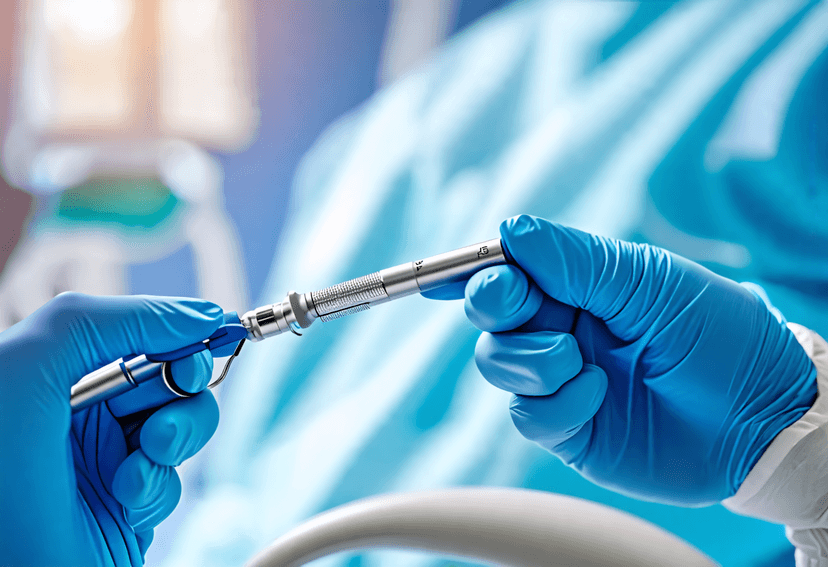
Early Detection: Your Best Defense Against Ovarian Cancer
26 Oct, 2023
 Healthtrip
HealthtripOvarian cancer is often referred to as the "silent killer" due to its subtle symptoms and late-stage diagnosis. This deadly disease, with a high mortality rate, affects thousands of women worldwide each year. However, early detection can significantly improve survival rates and the effectiveness of treatment. In this article, we will delve into the importance of early detection in the battle against ovarian cancer.
Understanding Ovarian Cancer
Before we discuss early detection, it's essential to understand what ovarian cancer is. Ovarian cancer originates in the ovaries, the female reproductive organs responsible for producing eggs and certain hormones. There are various types of ovarian cancer, with the most common being epithelial ovarian cancer. This type often goes undiagnosed until it reaches an advanced stage, making early detection crucial.
Most popular procedures in India
The Silent Threat
Ovarian cancer's nickname, the "silent killer," is not an exaggeration. Symptoms in the early stages of the disease are subtle and easily mistaken for other, less severe health issues. Some common early signs of ovarian cancer include:
- Bloating: Persistent bloating that doesn't subside with dietary changes or time.
- Pelvic or abdominal pain: Chronic pain or discomfort in the lower abdomen or pelvis.
- Difficulty eating: Feeling full quickly or having difficulty eating, even when you haven't consumed much.
- Urinary urgency: Increased frequency of urination, sometimes accompanied by discomfort.
- Fatigue: Unexplained and persistent fatigue, even after getting adequate rest.
Unfortunately, these symptoms are often attributed to less severe conditions, leading to delayed diagnosis. By the time ovarian cancer is diagnosed, it has often advanced to later stages, making it more challenging to treat effectively.
Wellness Treatments
Give yourself the time to relax
Lowest Prices Guaranteed!

Lowest Prices Guaranteed!
The Importance of Early Detection
Early detection can significantly improve the prognosis for ovarian cancer patients. Here's why it's crucial:
1. Improved Survival Rates
Ovarian cancer, when caught in its early stages (Stage I or II), has a significantly higher survival rate. The five-year survival rate for Stage I is around 90%, compared to just 28% for Stage III and 15% for Stage IV. Early detection allows for less aggressive treatment and a higher chance of a cure.
2. Less Aggressive Treatment
In advanced stages, ovarian cancer often requires more aggressive treatment, such as extensive surgery and chemotherapy. Early detection may allow for less invasive procedures and a shorter duration of chemotherapy, improving a patient's quality of life during and after treatment.
3. Better Quality of Life
Early detection not only leads to a higher chance of survival but also contributes to a better overall quality of life for ovarian cancer patients. Fewer complications, reduced side effects from treatment, and a shorter recovery time all play a role in this improved quality of life.
How to Detect Ovarian Cancer Early ?
Detecting ovarian cancer in its early stages requires a proactive approach. Here are some strategies for early detection:
1. Be Aware of Your Body
Understanding your body and recognizing any changes or persistent symptoms is the first step in early detection. If you experience any of the symptoms mentioned earlier, consult with a healthcare professional.
2. Regular Check-ups
Regular check-ups with your gynecologist can help in the early detection of ovarian cancer. Discuss your family history, any risk factors, and your concerns with your healthcare provider.
3. Risk Assessment
Knowing your risk factors for ovarian cancer is essential. Some risk factors, such as a family history of ovarian or breast cancer or the presence of certain gene mutations (e.g., BRCA1 and BRCA2), can increase your likelihood of developing the disease. If you are at higher risk, you and your healthcare provider may decide on more frequent and specialized screenings.
4. Screening Tests
While there is no routine screening test for ovarian cancer that is as effective as mammograms for breast cancer or Pap smears for cervical cancer, there are certain tests like transvaginal ultrasound and the CA-125 blood test that can be used in specific situations, especially for high-risk individuals. These tests are not foolproof but can be part of a comprehensive early detection strategy.
5. Genetic Testing
Genetic testing can help identify individuals with a high risk of developing ovarian cancer. If you have a family history of the disease, consider genetic testing to assess your risk and determine the best prevention and early detection plan for you.
Stages and Diagnosis of Ovarian Cancer
Understanding the stages and diagnosis of ovarian cancer is crucial in the quest for early detection and effective treatment. Ovarian cancer is typically categorized into four stages, with Stage I being the earliest and most treatable, and Stage IV representing the most advanced and challenging stage.
Stage I: Early Detection
In Stage I, ovarian cancer is confined to the ovaries. The cancer cells have not spread beyond this initial site. This is the ideal stage for early detection, as the tumor is localized. Survival rates for Stage I ovarian cancer are significantly higher compared to later stages.
Stage II: Localized Spread
Stage II is characterized by the cancer spreading beyond the ovaries but remaining within the pelvic region. It may involve nearby structures such as the fallopian tubes or the uterus. Early detection is still possible at this stage, and treatment can be effective.
Stage III: Regional Spread
By Stage III, ovarian cancer has extended to the abdominal lining, lymph nodes, or other organs within the abdominal cavity. The cancer may be more challenging to detect in this stage, and treatment becomes more complex. Survival rates decrease as the disease progresses.
Stage IV: Distant Metastasis
Stage IV is the most advanced stage of ovarian cancer. In this stage, the cancer has spread to distant organs and tissues, such as the liver, lungs, or even outside the abdominal cavity. Early detection is rare at this point, and the prognosis is considerably less favorable.
Diagnosis
Diagnosing ovarian cancer typically involves several steps:
- Clinical Evaluation: If a woman presents with symptoms suggestive of ovarian cancer (bloating, pelvic pain, urinary issues, etc.), her healthcare provider will conduct a clinical evaluation, which includes a medical history review and a physical examination.
- Imaging Tests: To visualize the ovaries and any potential abnormalities, imaging tests like transvaginal ultrasound and CT scans are often used. These tests can help identify the presence of tumors or cysts.
- Blood Tests: The CA-125 blood test measures the level of the CA-125 protein, which can be elevated in women with ovarian cancer. However, it's important to note that CA-125 levels can be elevated for various reasons other than cancer.
- Biopsy: A definitive diagnosis of ovarian cancer is usually made through a biopsy. A sample of tissue is removed and examined under a microscope to determine the presence of cancer cells. The biopsy may be obtained through surgery or minimally invasive procedures.
- Staging: If ovarian cancer is diagnosed, staging is performed to determine the extent of the disease. This typically involves additional imaging, such as CT scans and MRI, to assess how far the cancer has spread.
- Genetic Testing: In certain cases, genetic testing may be recommended, especially if there is a family history of ovarian or breast cancer. Genetic testing can identify specific mutations (e.g., BRCA1 and BRCA2) that increase the risk of developing ovarian cancer.
Early detection is most likely to occur when women pay attention to symptoms, seek prompt medical attention, and engage in regular check-ups with their healthcare providers. It is important to remember that while these diagnostic tools are valuable, they are most effective when combined with a proactive approach to monitoring one's health and understanding personal risk factors. Ovarian cancer is a formidable adversary, but through early detection and informed decision-making, it can be effectively managed and treated.
Treatment Options for Ovarian Cancer
The treatment of ovarian cancer depends on several factors, including the stage of the disease, the type of ovarian cancer, the patient's overall health, and their preferences. Ovarian cancer treatment typically involves a combination of approaches, which may include surgery, chemotherapy, targeted therapies, and, in some cases, radiation therapy. Let's explore these treatment options in more detail:
1. Surgery
Surgery is a fundamental component of ovarian cancer treatment and is often the first step after diagnosis. The extent of the surgery depends on the stage of the disease and the patient's overall health. Surgical options include:
- Debulking Surgery: In advanced stages (III and IV), debulking surgery aims to remove as much of the tumor as possible. This procedure can reduce the tumor burden and improve the effectiveness of other treatments.
- Hysterectomy: In many cases, a total hysterectomy is performed to remove the uterus and cervix. If the cancer has spread, the surgeon may also remove other nearby tissues or organs, such as the fallopian tubes or ovaries.
- Lymph Node Removal: The surgeon may remove nearby lymph nodes to check for cancer spread. This helps determine the stage and plan further treatment.
2. Chemotherapy
Chemotherapy is a systemic treatment that uses drugs to kill cancer cells or slow their growth. It is often administered after surgery and may also be used as a primary treatment for advanced stages of ovarian cancer. Chemotherapy can be given intravenously or directly into the abdominal cavity (intraperitoneal chemotherapy).
3. Targeted Therapies
Targeted therapies are a newer class of drugs that specifically target cancer cells, sparing healthy cells from damage. These therapies are often used in combination with chemotherapy. Bevacizumab and PARP inhibitors are examples of targeted therapies that have shown promise in the treatment of ovarian cancer.
- Bevacizumab (Avastin): This drug targets blood vessel growth in tumors, which can help shrink the tumor and improve the effectiveness of chemotherapy.
- PARP Inhibitors (e.g., Olaparib, Niraparib, Rucaparib): These drugs are effective in treating ovarian cancers with specific genetic mutations, such as BRCA1 or BRCA2. They interfere with the DNA repair process in cancer cells.
4. Radiation Therapy
Radiation therapy is less commonly used in the treatment of ovarian cancer but may be recommended in certain situations. It involves the use of high-energy X-rays to target and destroy cancer cells. It is typically used after surgery to treat any remaining cancer cells or to manage symptoms when the cancer has spread to other areas of the body.
5. Clinical Trials
Participating in clinical trials can provide access to innovative treatments and therapies that are still in the research and testing phase. These trials may offer new options for patients with ovarian cancer, potentially improving their outcomes.
6. Hormone Therapy
In some rare cases, ovarian cancer may be hormone-sensitive, meaning that hormones, such as estrogen, can fuel its growth. Hormone therapy may be used to block these hormones and slow down the cancer's progression.
7. Palliative Care
Palliative care focuses on improving the quality of life for patients with advanced ovarian cancer. It addresses pain management, symptom relief, and emotional support. It can be provided alongside curative treatment or as the primary focus in cases where the disease is not curable.
Personalized Treatment Plans
Each patient's ovarian cancer journey is unique. Treatment decisions should be based on the patient's specific diagnosis, stage, genetic markers, and overall health. Collaboration between the patient and a multidisciplinary healthcare team is essential to develop a personalized treatment plan that provides the best chance of remission or improved quality of life.
Ovarian cancer is a complex and challenging disease, but with advances in medical science, early detection, and effective treatments, many women diagnosed with this cancer can go on to lead fulfilling lives. It's essential for individuals and their healthcare providers to stay informed about the latest developments in ovarian cancer treatment and to work together to make the best decisions for each patient's care.
The Future of Ovarian Cancer Prevention and Detection
Looking ahead, the landscape of ovarian cancer prevention and detection is filled with promising prospects. Scientific and medical advancements are shaping the future of how we identify, prevent, and ultimately conquer this formidable disease. Here are some key areas of development and potential breakthroughs:
1. Vaccines: Ongoing research aims to develop vaccines that could help prevent certain types of ovarian cancer. These vaccines would target specific proteins associated with the disease, potentially reducing the risk of its development.
2. Targeted Therapies: Advances in understanding the genetic and molecular characteristics of ovarian cancer are leading to the development of more targeted and effective treatments. This may result in more successful outcomes, even in cases where early detection was not possible.
3. Screening Advances: Medical professionals are continuously working on improving screening methods for ovarian cancer. New and more accurate tests are on the horizon, offering the potential for earlier and more reliable detection.
4. Patient Advocacy: Organizations and support groups dedicated to ovarian cancer research, education, and patient advocacy play a vital role in the battle against the disease. These groups raise awareness, fund research, and provide valuable resources to both patients and their families.
The future of ovarian cancer prevention and detection holds the promise of earlier, more accurate diagnoses and more effective prevention strategies. As technology and medical knowledge continue to advance, there is hope for a future where ovarian cancer is not only detected early but prevented altogether, providing better outcomes and improved quality of life for those at risk of this insidious disease.
Conclusion
Early detection is the best defense against ovarian cancer, a disease often diagnosed at an advanced and difficult-to-treat stage. Recognizing the subtle symptoms, understanding your risk factors, and proactively seeking medical attention can make a significant difference in survival rates and the quality of life for those affected. Ovarian cancer is a formidable opponent, but with early detection, it's a battle that can be won. Your health and well-being depend on being vigilant and proactive in the face of this silent threat.
Read Also The Rising Concern: Ovarian Cancer in the UAE (healthtrip.com)
Related Blogs

Unraveling the Mysteries of Health: Expert Insights from Mayo Clinic
Get expert advice and insights from Mayo Clinic's renowned healthcare

Birthright: Empowering Women's Health and Wellness
Discover comprehensive healthcare services for women at Birthright, a renowned

The Link Between Autoimmune Disorders and Sarcoma
Explore the connection between autoimmune disorders and sarcoma cancer development

Sarcoma Cancer Causes and Risk Factors
Get informed about the causes and risk factors of sarcoma

The Importance of Early Detection in Sarcoma Cancer
Discover the benefits of early detection in sarcoma cancer treatment

Laparoscopic Hysteroscopy: A Minimally Invasive Diagnostic Tool
Explore the benefits of laparoscopic hysteroscopy, a minimally invasive diagnostic










